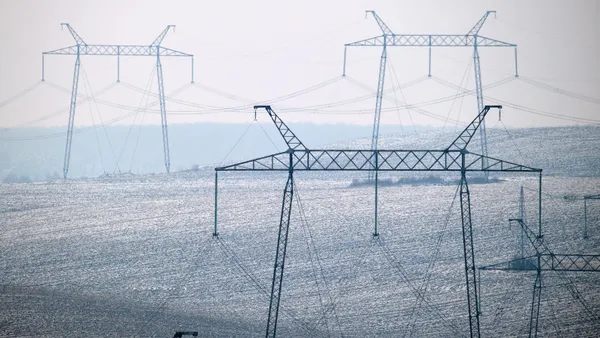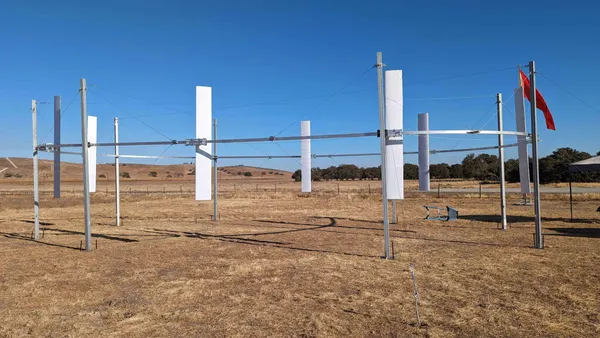Rising renewables growth shows mandates and incentives for them work. But customer demand for renewables has not slowed, creating a need for more energy storage to stabilize the grid.
That need for storage is estimated to be significantly bigger than current build-out plans, driven by existing policies, are likely to achieve. Many say more use of the competitive auctions that have helped drive renewables growth can also accelerate the deployment of storage.
In November 2018, 100 or more cities had 100% renewables commitments. Fortune 500 companies with 100% goals more than doubled in 2018 to 53. To reliably integrate such high levels of variable renewables into the grid, far more energy storage may be necessary, although storage incentives and mandates are lacking, with some notable exceptions like California, New York and Massachusetts. But market-based auctions may propel procurement of energy storage.
Energy storage "is particularly well suited" to cost-effectively meet the "critical challenge" to grid reliability created by high levels of variable renewables, according to a new study from the Environmental Defense Fund (EDF). This is because it can store excess renewables generation when prices are low and dispatch the power on demand.
Energy storage can make it "easier, quicker, and cheaper" to integrate those rising levels of renewables because it can smooth the supply disruptions caused by "cloudy days or calm nights," David Hart, Information Technology and Innovation Foundation (ITIF) senior fellow recently wrote.
Getting the United States to very high levels of renewables "could take 10,000 GWh of battery storage, which is a huge amount of an expensive technology," Maureen Lackner, EDF Economics and Policy Analyst and paper co-author, told Utility Dive. A December 2018 Wood Mackenzie-Energy Storage Association (ESA) report found the total U.S. installed battery energy storage capacity at just over 500 MWh.
"Solicitations that put all bids on a level playing field, define attributes the utility needs, and are open to all sources are proving to be the storage industry’s best friend."

Lon Huber
Energy director, Navigant
Reversed auctions
Recent renewables procurements have reversed the traditional auction structure of a single seller and multiple buyers. Instead, one utility buyer has solicited bids from multiple sellers. These market-driven procurements, designed to maximize competition, have long been used by utilities to procure resources. In recent solicitations, they have unexpectedly delivered not just low-cost renewables but low-cost renewables-plus-energy storage products.
It is important to have technology agnostic competition into procurements to obtain the most benefit for ratepayers, Lon Huber Navigant energy director told Utility Dive. "Solicitations that put all bids on a level playing field, define attributes the utility needs, and are open to all sources are proving to be the storage industry's best friend."
Some say the early successes of competitive solicitations may not be sustainable. Auctions could induce under-bidding that forces out smaller providers, leaving fewer competitors in the market to drive down prices, Meredith Fowlie, economics professor at University of California, Berkeley, recently wrote.
But first-mover auctions by Arizona's Tucson Electric Power (TEP), Colorado's Xcel Energy and Hawaii's Hawaiian Electric Co. (HECO) surprised the utilities with energy storage offers they could not refuse.
"There are opportunities utilities don't know about," Carmine Tilghman, Array Technologies Senior VP for commercial operations, told Utility Dive. Tilghman led the design of the TEP auction, one of the first to select cost-competitive solar-plus-storage bids. "Our solicitation allowed market participants to show us those opportunities."
Emission reductions
The 80% reduction in U.S. emissions from 2005 levels by mid-century that is minimally needed in the fight against climate change will require trillions in new generation, energy storage and transmission, Geoffrey Heal, Columbia University Earth Institute Center economist, wrote in his 2017 paper. More storage is "crucial" to reducing the investment in renewables by expanding their efficiency, Heal reported.
Though Heal estimated 10,000 GWh of storage are needed to reach the 2050 goal, the U.S. is expected to deploy less than 12 GWh by 2023, according to the December 2018 Wood Mackenzie-Energy Storage Association (ESA) report.
Making up the significant difference between the storage being built and what is needed will require "innovative policy solutions," and market-based auctions could "quickly and cost-effectively increase our energy storage capacity," the EDF authors recently blogged.
At least 48 countries are already using renewables auctions and 27 countries are "seriously considering the idea," UC Berkeley's Fowlie recently wrote.
Some oppose auctions because they threaten support for incentives like feed-in tariffs (FiTs), she added. FiTs guarantee renewables owners and above-market price for the generation their systems export to the grid. But even in Germany, where FiTs led to 38 GW of solar capacity, recent auctions produced record low prices for utility-scale photovoltaic solar and offshore wind.
Despite concerns about under-bidding and driving out smaller competitors, this "auctions revolution" is "accelerating price discovery and reducing procurement costs," Fowlie said.
To attract the storage needed, auctions must be designed to take advantage of energy storage systems' ability to provide a stack of revenue opportunities that ranges from dispatchable energy to energy arbitrage, the EDF paper said. The design should also attract "innovative technologies" and "guarantee timely delivery of new capacity."
Early U.S. auctions
U.S. auctions have begun to reveal the mechanism's potential to grow energy storage.
California's Renewable Auction Mechanism (RAM) was an early U.S. auction success which led to the procurement of 1,604 MW of small project renewables between 2014 and 2018, according to a 2018 California Public Utilities Commission (CPUC) report. "It allowed bidders to set their own price and use a standard contract."
The RAM "minimized transaction costs for the seller, buyer, and the regulator and shortened the overall procurement process timeline," though some simplicity was lost to revisions that moved away from price-only bid evaluations, Terrie Prosper, CPUC spokesperson, emailed Utility Dive.
Selection of renewables based on only the lowest per-kWh price does not allow a clear comparison of resources with and without storage because of storage's multiple value streams, Navigant's Huber noted. "But bids for solar-plus-storage in recent years have come in so close to bids for solar-only that utilities have started looking at the storage's system value to justify the slight premium."
The 2017 TEP solicitation showed auctions structured to allow developers to bid renewables-plus-storage projects could attract cost-competitive offers when solar-plus-storage was bid at "significantly less than $0.045/kWh," Tilghman said.
The 100 MW solar installation was $0.027/kWh, he added. The estimated $0.015/kWh price for the 30 MW, 120 MWh energy storage component was justified by its use to replace high capital cost natural gas units for meeting TEP's seasonal demand peaks.
Storage was considered too expensive, "but we thought it was time to find out from the market," Tilghman said. The solicitation was designed to attract bids for solar projects, "but it allowed vendors to offer two optional bids with additional services, like storage."
For comparison purposes, bids were required to include per-MWh prices. "The $0.045/kWh estimate for solar-plus-storage was below the incremental natural gas fuel cost," Tilghman recalled. "We realized it would also offset fuel hedging, start-stop, and maintenance costs, which made that price reasonable, practical, and justifiable."
One important takeaway from the TEP procurement was that the solicitation should give bidders flexibility to offer products new to the utility's resource portfolio, Tilghman said. Another was that the utility should assess those products' values against the costs they can offset.
Both elements were key to HECO's procurement, announced in January, of seven solar-plus-storage contracts representing 262 MW of solar and 1,048 MWh of storage, Colton Ching, Senior VP for planning and technology, told Utility Dive at the time. Six, at $0.08/kWh to $0.10/kWh, are Hawaii's lowest-priced renewables contracts, and the seventh, at $0.12/kWh, is below HECO's cost of fossil fuel generation.
The solicitation "focused on renewable energy, but our parameters allowed developers to bid with storage," Ching said. "Adding storage made the projects more expensive, but the cost increase was not as great as the increased value of being able to use the solar generation when we choose to optimize our system."
"The mindset has shifted," Navigant's Huber said. "Early on, solar was not thought to be dispatchable or useful to serve peak demand needs. Storage changed that, but it was thought to be too expensive. All-source solicitations are changing that."
The breakthrough U.S. auction
The Xcel Energy Colorado 2017 all-source solicitation shook the U.S. power sector when bid prices set new record lows. Wind bids ranged from $11/MWh to $18/MWh, solar bids ranged from $23/MWh to $27/MWh, and solar-plus-storage bids ranged from $30/MWh to $32/MWh, according to Xcel's 120-Day Report, filed June 6, 2018, with Colorado regulators.
From over 400 bids representing over 112,000 MW of capacity, Xcel selected 11 projects representing 2,221 MW. Now approved by the Colorado Public Utilities Commission and under final negotiation, they include three solar-plus-storage projects representing 560 MW of solar capacity and 275 MW/1,000 MWh of battery storage.
"The big surprise in those bids was how cost competitive battery storage was when embedded in a solar plant."

Kent Scholl
Senior resource planning analyst, Xcel Energy
Colorado PUC guidance ensures evaluation of "all types of resources," Kent Scholl, Xcel Energy's senior resource planning analyst, told Utility Dive. The 2017 request for proposals (RFP) included categories for dispatchable, renewable and semi-dispatchable resources. The third category included "any other intermittent resource with storage or fuel backup."
Xcel used computer-based modeling to determine each proposal's "value to our existing portfolio," Scholl said. "The big surprise in those bids was how cost competitive battery storage was when embedded in a solar plant."
Scholl expects more storage to be bid into its next all-source solicitation, scheduled for 2020, and is planning more specifics for its RFP documents. "We are learning the intricacies of storage, and the next proposal will be more specific about what we expect from bidders, so they don't have to guess what is of value to the company."
That is the type of solicitation that can deliver more energy storage, EDF Economics and Policy Analyst and paper co-author Steve Koller told Utility Dive. "A well-designed RFP can match specific system needs with developers who can meet them."
Successfully including energy storage in solicitations "will depend to a significant extent on the gritty auction design details," Fowlie agreed.
Better U.S. auctions
"Smart policy design can help drive energy storage prices even further below current historic lows," EDF reported. It can also "ensure delivery of quality projects."
An auction to solicit resources must be precisely designed to allow the multiple revenue streams of energy storage to be valued and used, EDF's Lackner added. But "we are still working to understand the auction design criteria needed to allow battery storage to bid on a level playing field."
A key auction design guideline is that "the more developers bidding into an auction, the fiercer the competition," the EDF paper said. But auctioned capacity should be limited because "bidders respond to a supply squeeze by decreasing their bid prices."
Renewable auctions can benefit "tremendously" from "companion policies" like state mandates and federal tax credits, EDF also found. Policies enabling competitive solicitations "must be supported by other policies in a more complicated policy landscape," Lackner explained.
Another guideline is that solicitations must be carefully designed to avoid unintentionally favoring larger providers and more mature technologies, EDF said. "Any market-based policy should reserve some opportunity for innovation because technologies that are cost-effective now may not be in 5 years or 10 years," Koller explained.
A 10% carve-out in procurement targets or mandates "might help create a market for less mature technologies and battery chemistries," ITIF's Hart suggested.
Finally, auction designs should include penalties for developers who do not deliver, EDF warned. "Competition can drive prices down, but poor auction design can trigger a race to the bottom with ever more unrealistic bid prices."
"Many of TEP's innovative products over the years came from giving developers enough flexibility to be creative in their bids while staying within a basic framework," Array's Tilghman agreed. "That is how utilities can get the biggest bang for their dollars."













